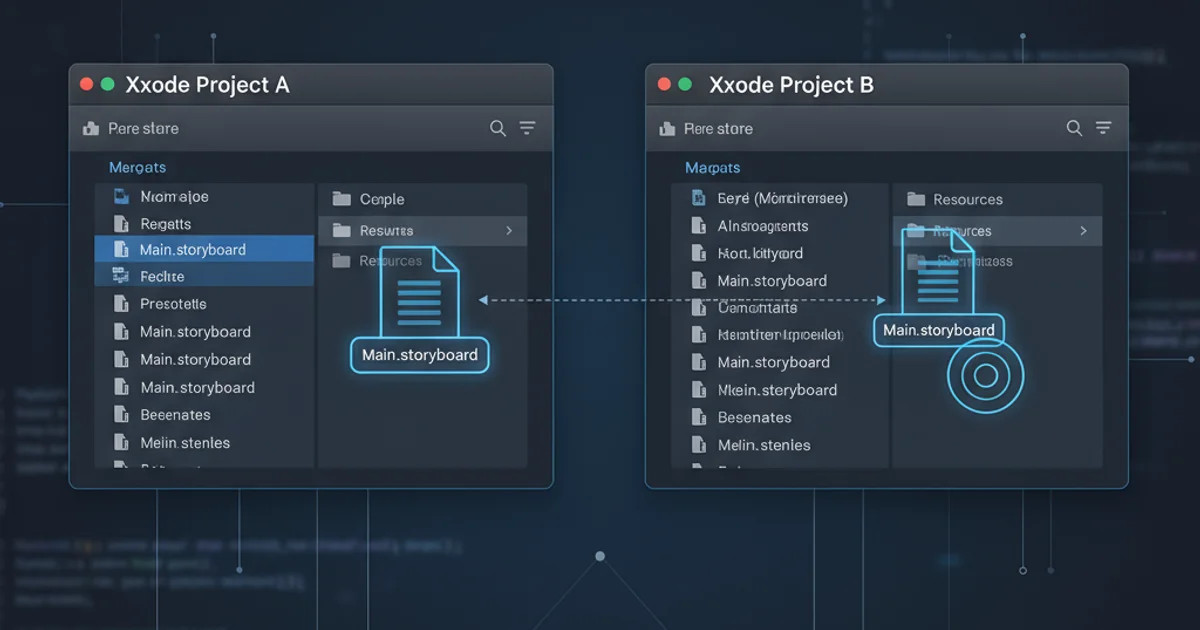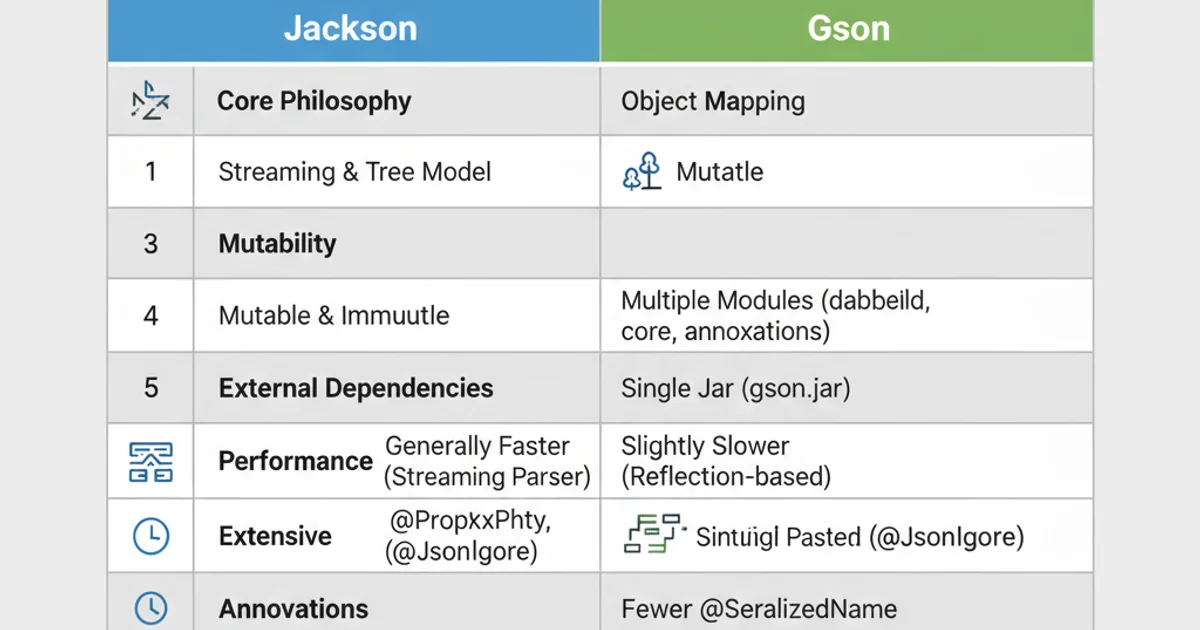How to parse JSON in Java
Categories:
Mastering JSON Parsing in Java: A Comprehensive Guide

Learn how to effectively parse JSON data in Java using popular libraries like Jackson and Gson, covering basic object mapping, nested structures, and error handling.
JSON (JavaScript Object Notation) has become the de-facto standard for data interchange in modern web applications. Its human-readable format and lightweight nature make it ideal for APIs, configuration files, and data storage. As a Java developer, understanding how to efficiently parse and manipulate JSON data is a fundamental skill. This article will guide you through the process, focusing on two of the most widely used and robust libraries: Jackson and Gson.
Understanding JSON Structure
Before diving into parsing, it's crucial to grasp the basic structure of JSON. JSON data is built upon two primary structures:
- Objects: Represented by curly braces
{}, objects are unordered sets of key/value pairs. Keys are strings, and values can be strings, numbers, booleans, null, arrays, or other JSON objects. - Arrays: Represented by square brackets
[], arrays are ordered collections of values. Values can be of any JSON data type.
graph TD
A[JSON Data] --> B{Is it an Object?}
B -->|Yes| C[Key-Value Pairs]
B -->|No| D{Is it an Array?}
D -->|Yes| E[Ordered List of Values]
D -->|No| F[Primitive Value (String, Number, Boolean, Null)]
C --> G[Value can be Object, Array, or Primitive]
E --> GBasic JSON Structure Flowchart
Parsing JSON with Jackson
Jackson is a high-performance JSON processor for Java. It's widely adopted due to its flexibility, speed, and comprehensive features, including streaming API, data binding, and tree model. To use Jackson, you'll need to add its dependencies to your project (e.g., Maven or Gradle).
For Maven projects, add the following dependency to your pom.xml:
<dependency>
<groupId>com.fasterxml.jackson.core</groupId>
<artifactId>jackson-databind</artifactId>
<version>2.15.2</version>
</dependency>
Object Mapping with Jackson
The most common way to parse JSON with Jackson is using object mapping. This involves defining Java classes that mirror your JSON structure. Jackson then automatically maps JSON fields to Java object properties.
import com.fasterxml.jackson.databind.ObjectMapper;
import java.io.IOException;
// Define a simple POJO (Plain Old Java Object) for our JSON
class User {
public String name;
public int age;
public String email;
// Default constructor is required for Jackson
public User() {}
public User(String name, int age, String email) {
this.name = name;
this.age = age;
this.email = email;
}
@Override
public String toString() {
return "User{" +
"name='" + name + '\'' +
", age=" + age +
", email='" + email + '\'' +
'}';
}
}
public class JacksonParsingExample {
public static void main(String[] args) {
String jsonString = "{\"name\":\"John Doe\", \"age\":30, \"email\":\"john.doe@example.com\"}";
ObjectMapper objectMapper = new ObjectMapper();
try {
// Convert JSON string to Java object
User user = objectMapper.readValue(jsonString, User.class);
System.out.println("Parsed User: " + user);
// Convert Java object back to JSON string
String newJsonString = objectMapper.writeValueAsString(user);
System.out.println("User to JSON: " + newJsonString);
} catch (IOException e) {
e.printStackTrace();
}
}
}
Basic JSON parsing and serialization with Jackson's ObjectMapper.
Parsing Nested JSON Objects and Arrays
Real-world JSON often involves nested objects and arrays. Jackson handles these complex structures seamlessly, provided your Java POJOs accurately reflect the JSON hierarchy.
import com.fasterxml.jackson.databind.ObjectMapper;
import java.io.IOException;
import java.util.List;
class Address {
public String street;
public String city;
public String zipcode;
public Address() {}
@Override
public String toString() {
return "Address{street='" + street + "', city='" + city + "', zipcode='" + zipcode + "'}";
}
}
class Employee {
public String id;
public String name;
public List<String> skills;
public Address address;
public Employee() {}
@Override
public String toString() {
return "Employee{id='" + id + "', name='" + name + "', skills=" + skills + ", address=" + address + "}";
}
}
public class JacksonNestedParsingExample {
public static void main(String[] args) {
String nestedJson = "{\"id\":\"EMP001\",\"name\":\"Jane Doe\",\"skills\":[\"Java\",\"Spring\",\"SQL\"],\"address\":{\"street\":\"123 Main St\",\"city\":\"Anytown\",\"zipcode\":\"12345\"}}";
ObjectMapper objectMapper = new ObjectMapper();
try {
Employee employee = objectMapper.readValue(nestedJson, Employee.class);
System.out.println("Parsed Employee: " + employee);
System.out.println("Employee's City: " + employee.address.city);
} catch (IOException e) {
e.printStackTrace();
}
}
}
Parsing JSON with nested objects and arrays using Jackson.
Parsing JSON with Gson
Gson is Google's JSON library for Java. It's known for its simplicity and ease of use, often requiring less boilerplate code than Jackson for basic scenarios. Like Jackson, you'll need to add the Gson dependency to your project.
For Maven projects, add the following dependency to your pom.xml:
<dependency>
<groupId>com.google.code.gson</groupId>
<artifactId>gson</artifactId>
<version>2.10.1</version>
</dependency>
Object Mapping with Gson
Gson also uses object mapping to convert JSON strings into Java objects and vice-versa. The process is very similar to Jackson, requiring POJOs that match the JSON structure.
import com.google.gson.Gson;
// Reusing the User class from the Jackson example
// class User {
// public String name;
// public int age;
// public String email;
//
// public User() {}
//
// public User(String name, int age, String email) {
// this.name = name;
// this.age = age;
// this.email = email;
// }
//
// @Override
// public String toString() {
// return "User{" +
// "name='" + name + '\'' +
// ", age=" + age +
// ", email='" + email + '\'' +
// '}';
// }
// }
public class GsonParsingExample {
public static void main(String[] args) {
String jsonString = "{\"name\":\"Jane Smith\", \"age\":25, \"email\":\"jane.smith@example.com\"}";
Gson gson = new Gson();
// Convert JSON string to Java object
User user = gson.fromJson(jsonString, User.class);
System.out.println("Parsed User: " + user);
// Convert Java object back to JSON string
String newJsonString = gson.toJson(user);
System.out.println("User to JSON: " + newJsonString);
}
}
Basic JSON parsing and serialization with Gson.
Handling Missing Fields and Errors
When parsing JSON, it's common to encounter situations where fields might be missing or data types don't match. Both Jackson and Gson provide mechanisms to handle these scenarios gracefully.
null for objects, 0 for int, false for boolean). If a JSON field is present but not in the POJO, it will typically be ignored. However, type mismatches will usually throw exceptions.import com.fasterxml.jackson.databind.ObjectMapper;
import com.fasterxml.jackson.databind.DeserializationFeature;
import java.io.IOException;
// Reusing the User class
public class JacksonErrorHandlingExample {
public static void main(String[] args) {
String jsonMissingField = "{\"name\":\"Bob\", \"email\":\"bob@example.com\"}"; // 'age' is missing
String jsonTypeMismatch = "{\"name\":\"Alice\", \"age\":\"twenty\", \"email\":\"alice@example.com\"}"; // 'age' is string, not int
ObjectMapper objectMapper = new ObjectMapper();
// Configure Jackson to fail on unknown properties (optional, but good practice)
objectMapper.configure(DeserializationFeature.FAIL_ON_UNKNOWN_PROPERTIES, false);
try {
System.out.println("--- Missing Field Example ---");
User user1 = objectMapper.readValue(jsonMissingField, User.class);
System.out.println("Parsed User (missing age): " + user1); // age will be 0
System.out.println("\n--- Type Mismatch Example ---");
User user2 = objectMapper.readValue(jsonTypeMismatch, User.class);
System.out.println("Parsed User (type mismatch): " + user2);
} catch (IOException e) {
System.err.println("Error parsing JSON: " + e.getMessage());
}
}
}
Handling missing fields and type mismatches with Jackson.
Choosing Between Jackson and Gson
Both Jackson and Gson are excellent choices for JSON parsing in Java. Your decision might depend on specific project requirements or personal preference:
- Jackson: Generally preferred for high-performance applications, complex mappings, and when fine-grained control over serialization/deserialization is needed. It has a larger ecosystem and more advanced features.
- Gson: Often chosen for its simplicity, ease of use, and when quick integration is a priority. It's very developer-friendly for straightforward JSON structures.

Jackson vs. Gson: A quick comparison.
By mastering these libraries, you'll be well-equipped to handle any JSON parsing challenge in your Java applications.